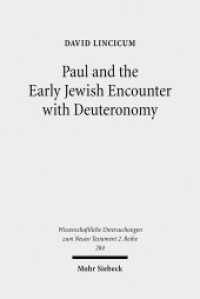Full Description
Because dance materializes through and for people, because we learn to dance from others and often present dance to others, the moment of its transmission is one of dance's central and defining features. Valuing Dance looks at the occasion when dancing passes from one person to another as an act of exchange, one that is redolent with symbolic meanings, including those associated with its history and all the labor that has gone into its making. It examines two ways that dance can be exchanged, as commodity and as gift, reflecting on how each establishes dance's relative worth and merit differently. When and why do we give dance? Where and to whom do we sell it? How are such acts of exchange rationalized and justified? Valuing Dance poses these questions in order to contribute to a conversation around what dance is, what it does, and why it matters.
Contents
Introduction
Chapter 1 - Dance's Resource-fullness
Dance as Bringing People into Relation
Dance as Energizing
Dance as Adapting
Chapter 2 - Commodifying and Giving
Part A - Dance as Commodity
Standardizing, Spectacularizing, and Promoting
Bringing People into Relation as Constructing Interactivity
Energizing as Targeting Vitality
Adapting as Developing Transportability
Part Z - Dance as Gift
Giving, Receiving, and Reciprocating
Bringing People into Relation as Affirming Connectivity
Energizing as Embracing Irrepressibility
Adapting as Cultivating Locality
Chapter 3 - The Social Life of Dances
The Global Reach of Hip Hop
Learning to Dance in the Privately Owned Studio
On the Powwow Circuit
Chapter 4 - Why Dance?
Why Sell?
Why Give?
Who is Dancing?
Philosophies of Giving - Deborah Hay, William Forsythe, Savion Glover
Index








